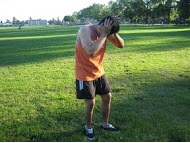Giant cell arteritis is an inflammation of the lining of the arteries which are blood vessels that functions in carrying oxygen rich blood from the heart to the rest of the body. It usually affects the arteries of the head and the temples and it is also known as temporal arteritis or cranial arteritis.
[youtube url=”https://www.youtube.com/watch?v=7FQoDaFLyFQ”]Giant cell arteritis causes headaches, pain in the jaw, blurred or double vision, and even blindness. The most serious complication of giant cell arteritis is stroke. An immediate treatment of giant cell arteritis is critical in order to prevent a permanent damage of the tissue and vision loss. If you want to learn how to properly manage this condition, read here.
Symptoms of giant cell arteritis

Common symptoms of giant cell arteritis include head pain and tenderness that are often severe and affect both temples. Sometimes the symptoms are similar to flu with stiffness of the muscle and aches felt around the shoulders and hips or myalgia and there is fatigue, fever and headache. Some common symptoms of giant cell arteritis include the following:
- Loss of vision or double vision
- There is a persistent, severe head pain and tenderness in the temple area
- There is tenderness of the scalp and pain when combing the hair or even lying the head in a pillow when the arteries are inflamed.
- A sudden or permanent vision loss in one eye
- There is jaw pain or jaw claudication when chewing or opening the mouth wide
- Experiencing unexplained loss of weight and fever
Causes of giant cell arteritis
Giant cell arteritis is caused by the inflammation of the lining of the arteries and develops in the head, usually in the temporal arteries that separates from a blood vessel found in the neck which is called the carotid artery. Corticosteroid medications help in minimizing the symptoms and even for complete recovery.
There are complications that can be caused by giant cell arteritis like blindness, where there is a decrease of blood flow to the eyes and causes sudden and painless loss of vision in one or both the eyes and it is usually permanent. An aortic aneurysm is a serious condition which causes internal bleeding and a blood clot can form in the affected artery causing obstruction to the flow of blood to the brain and can cause a stroke.
Treatment and home remedies
- Eat a healthy diet to help prevent possible problems like thinning of the bones, diabetes and high blood pressure. Eat a variety of fruits and vegetables, whole grains, lean meats and fish. Minimize the use of salt, sugar and alcohol. Take calcium and Vitamin D supplements at least 1000 and 1200 milligrams of calcium and 800 IU or international units of Vitamin D every day.
- Perform exercises regularly such as aerobic exercise like walking since it can help in preventing loss of bone, diabetes and blood pressure and also beneficial to the heart and lungs. Exercising regularly will improve the mood and an overall sense of well-being. Exercise regularly at least 30 minutes a day.
